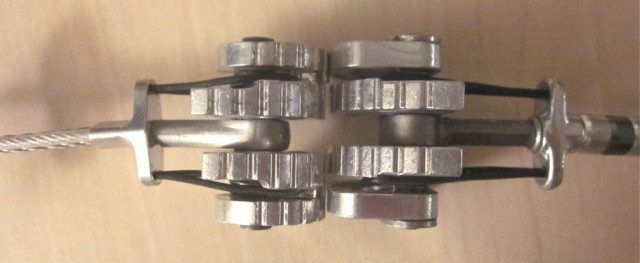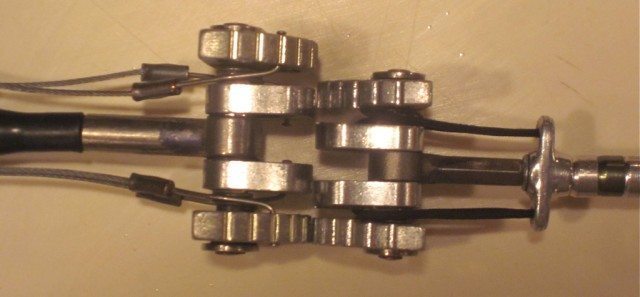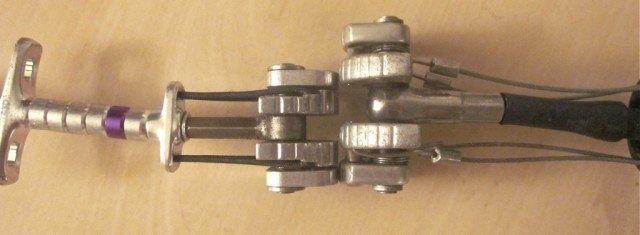Black Diamond Camalot X4

Sizes Tested: 0.1, 0.2, 0.5, 0.75
Strength:
- 0.1 — 5 kN
- 0.2 — 6 kN
- 0.3 — 8 kN
- 0.4 — 9 kN
- 0.5 — 9 kN
- 0.75 —9 kN
Weight :
- 0.1 — 51 g
- 0.2 — 54 g
- 0.3 —75 g
- 0.4 — 82 g
- 0.5 — 91 g
- 0.75 —112 g
Range:
- 0.1 — 8.4-13.8 mm
- 0.2 — 9.9-16.5 mm
- 0.3 — 12.4-21.2 mm
- 0.4 — 15.5-26.6 mm
- 0.5 —19.8-33.7 mm
- 0.75 — 24-41.2 mm
Days Tested: ~4 months
Locations Tested: Clear Creek Canyon, Boulder Canyon, CO; Index, WA; Vedauwoo, WY
The Black Diamond X4, the latest small cam that bears some family resemblance to the CCH Alien, arrived this year to high expectations. For me at least, this was a welcome addition to Black Diamond’s line-up. Although the company’s C3 line already covers the range of the smaller X4 sizes (while the larger X4s overlap with the Black Diamond C4 line), the C3 design has several drawbacks that leave it a step or two behind the Metolius Master Cam or the recent Alien clones made by Totem and Fixe.
(And it might be helpful to check out our Cams 101: Glossary before reading the following review.)
Sizes
I bought four of the six X4 sizes earlier this season and brought them with me every time my trad rack saw the light of day. Since I used them mostly in the summer months, they haven’t seen much sandstone.
I tested the 0.1, 0.2, 0.5, and 0.75—the two smallest and largest sizes. Interestingly, there are significant design differences across the line, particularly between the smaller half of the line (0.1, 0.2, 0.3) and the larger half (0.4, 0.5, 0.75). I’ll get into those specifics a bit later on.
I haven’t climbed yet with the 0.3 or 0.4, so while I think the four sizes I did climb with represent the X4 line well, please keep that in mind.
A Few Comparisons
The X4 challenges the paradigmatic understanding that certain designs (Single or U-stem? Three lobes or Four?), come with certain compromises. Like the C3, the X4 attempts to find a balance between four-lobed, single-stem cams and TCUs.
The C3 cams do this nicely in several ways—they have the extremely narrow head width (and high lobe surface area relative to head width) of TCUs, but the dual stem sits inside so the cams fit into flares a bit better than the classic U-stem TCU. The C3s also have some stem flexibility (in one direction at least), a quality typically found in single-stem cams.
The X4s have an extremely narrow head for a single-stem cam, a difference that’s less pronounced in the smaller sizes. The head width on the 0.1 X4, for example, is comparable to the purple 0 Master Cam.
On the other hand, the 0.5 and 0.75 X4s (the largest two of the six), are dramatically thinner than comparably sized C4s, Helium Friends, or Master Cams. In fact, the four cam lobes on the 0.5 and 0.75 X4 sit in the same space as just three of the four lobes found on the same size Black Diamond C4.



NEXT PAGE: The Stem

You’ve written:
On the other hand, the 0.5 and 0.75 X4s (the largest two of the six), are dramatically thinner than comparably sized C4s, Helium Friends, or Master Cams. In fact, the four cam lobes on the 0.5 and 0.75 X4 sit in the same space as just three of the four lobes found on the same size Black Diamond C4.
Do you think that this is a disadvantage? I meat that the more narrow head is the less placement is stable? I think that with 0.75 with reduced head width (between BD C4 and X4) you can put it in more tricky placement. But, well, stability…
And the second thing about X4. Sometimes I find it too flexible – a cable is bending during closing lobes. Have you such issue? But the ones that I’ve used really needed greasing.
Regarding the stability, I haven’t noticed that to be a concern as a function of the head width. In fact, when the stem acts to rotate the cam, the wider head will have a longer “lever” in terms of the basic mechanics involved and significan’t off-set the stability that you might get from the head having a wide “stance.” Additionally, the soft stems (relative to Black Diamond C4s, Helium friends, etc.) help isolate the lobes from the movement of the rope in the same way, but to a lesser extent, as a sling. In the real world, I haven’t seen any actionable difference between stability in the X4s and the Black Diamond C4s in the same size, and any slim difference is easily overcome by the ability to work with thinner (or slightly flaring) placements.
As for the softness of the stem, this is definitely the type of issue that colors peoples experience with one cam or another. While truly rigid stems are obviously impractical, a really heavy cam (say, off fingers or thin hands sizes) on a super soft stem can be irksome. Pairing excessively stiff springs with a soft stem can be equally problematic. As for the X4s, I use the 0.75 regularly without much trouble from the soft stem. In fact, as far as the stiffness of the stems go, I generally have an easier time with the 0.75 X4 than with the comparably sized black Metolius Mastercam.
This is definitely wading into personal preference, though, and I do know other climbers who don’t like to use those types of single stem cams (Mastercams, X4s, Aliens, etc.) in sizes any larger than perfect fingers. In my opinion, the real issue with the stem on the X4s is the needlessly short stem on the two smallest sizes. They threaten to get stuck with some regularity despite otherwise being excellent micro cams.